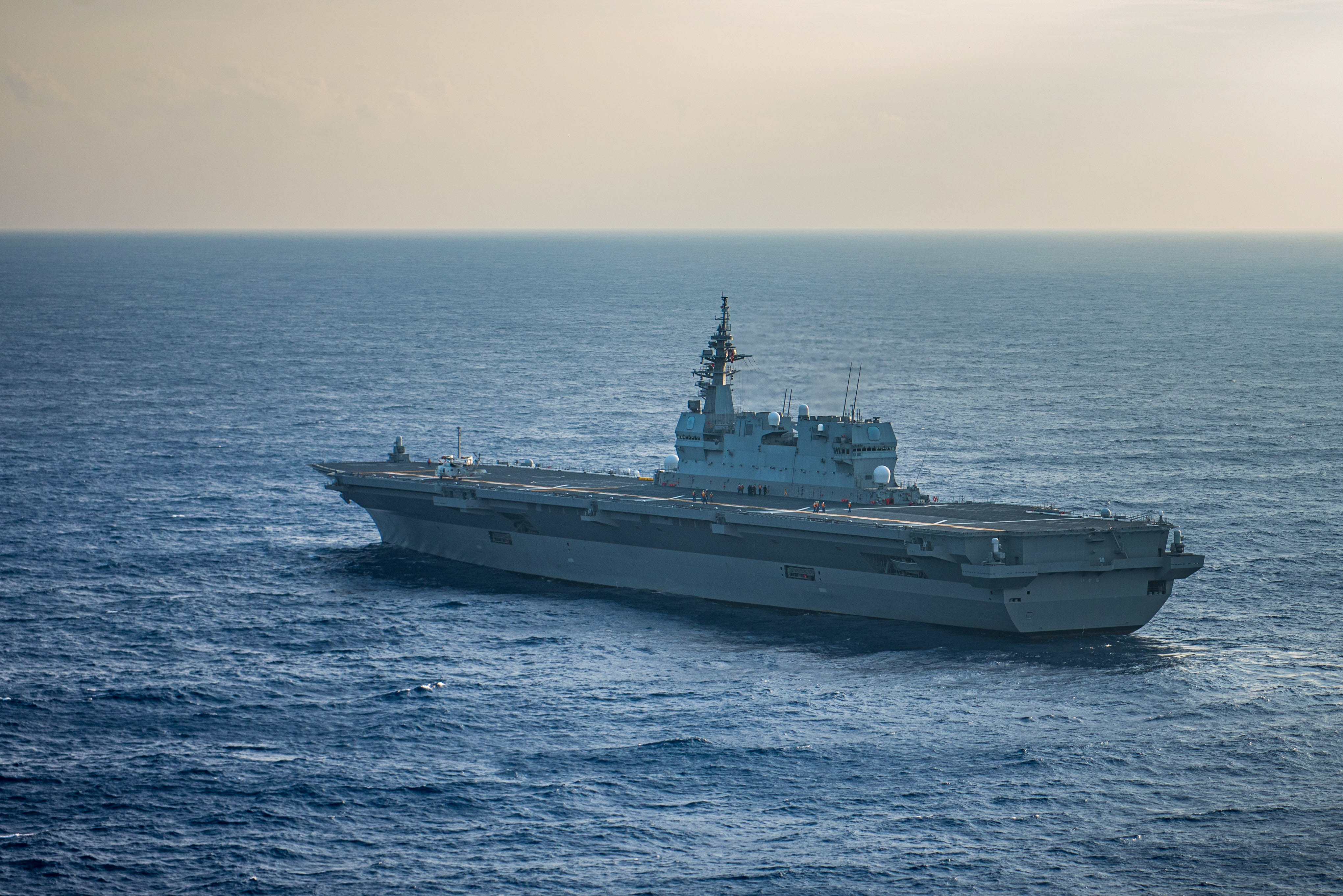
One of Japan’s largest warships is heading to the East Coast next year to conduct a series of F-35B Lightning II Joint Strike Fighter trials next year, USNI News has learned.
The plan for a Japanese Maritime Self-Defense Force (JMSDF) Izumo-class warship comes as Royal Navy carrier HMS Prince of Wales (R09) completes the third phase of a series of F-35B tests off the East Coast. The JMSDF is expected to conduct similar trials in the same waters a year from now with an Izumo-class destroyer carrier.
The DT-3 (Development Test, phase three) trials aboard Prince of Wales were conducted over a four-week period alongside operational trials of Marine Corps MV-22 Ospreys, CH-53E Super Stallions and AH-1Z Viper gunships and supply drones on the carrier, according to a Wednesday Royal Navy release. DT-3 used two specially instrumented F-35Bs with three Marine Corps test pilots and a 180-strong support team from Naval Air Station Patuxent River, F-35 Integrated Test Force (PAX ITF), which is responsible for testing all sea-going F-35 variants and comprised of personnel from the U.S Navy and Marine Corps, Royal Air Force, Lockheed Martin, British Aerospace, Northrop Grumman and U.S. government civilian personnel.
DT-3 follows the DT-1 and DT-2 trials, which were conducted on HMS Queen Elizabeth (R08) in 2018. During October and early November, close to 150 short takeoffs (STOs), approximately 80 vertical landings (VLs), and 60 shipborne rolling vertical landings (SRVLs) were carried out while PAX ITF flight-test engineers collected data, compared it to models and made initial analyses, according to a release issued by the Pentagon on Thursday.
“The integration of our teams to realize approximately 150 test points of the F-35B program will potentially increase the way the U.K can operate the F-35,” said RN Lt. Cdr. Jamie Elliott, Air Engineering Department Head, in the release. “SRVL, night SRVL, and heavy load (bombs) test points yielded data that will inform any future decisions about the possible F-35B operational clearance to take off and land heavier, operate in heavier sea states, and turn the jets around faster for more sorties.” During SRVLs, the F-35Bs conduct conventional deck landings, which allow the aircraft to land without having to dump fuel or ditch unused ordnance, in contrast when conducting hovering landings.
Trials were also carried out with the F-35Bs carrying the maximum load of 22,000 lb, according to a Royal Navy release on Oct. 20, with a PAX ITF F-35B being loaded with a combination of inert 500-pound Paveway IV laser-guided bombs and inert 1,000-pound Paveways.
Norfolk 2 completed!!!!
Defence Engagement over 500 guests! ✅
Rugby vs Norfolk Blues ✅
Visited Annapolis ✅
New airframes embarked ✅
Remembrance…
And our friendly 4 legged 🦮Ike is back!
Back to sea…
🇬🇧🤝🇺🇸 pic.twitter.com/imccwMsc2G
— HMS Prince of Wales (@HMSPWLS) November 13, 2023
A JMSDF delegation observed portions of the trials, according to a Nov.1 Royal Navy release, “helping to pave the way for their own trials in the same waters in 12 months’ time.” The Japanese delegation was led by JMSDF Capt. Tsuyoshi Sato, Izumo-class special modification program lead, and consisted of five other officers from the JMSDF and Japan Air Self Defense Force (JASDF).
The JMSDF does not have a naval aviation fighter component and Japan’s F-35Bs likely will be operated by a JASDF squadron. Japan will receive six F-35Bs in 2024 from a total order of 42 aircraft and a provisional F35B squadron will be established the same year. Japan conducted initial trials with Marine Corps F-35Bs on JS Izumo (DDH-183) in October 2021 but has not conducted further trials.
Prince of Wales arrived in Mayport, Florida, on Sept. 22 as part of its Westlant 2023 deployment. The carrier is currently in Norfolk Virginia but will soon depart to conduct further aviation trials with pilotless aircraft along with combined training with the U.S. Marine Corps.
On the other side of the globe, in Australia, AUKUS nations conducted an exercise off the east coast of Australia – Integrated Battle Problem 23.3 (IBP 23.3) – testing autonomous undersea warfare capabilities, according to an Australian Department of Defence release on Friday. The Navy’s Ghost Fleet of USVs – Ranger, Mariner, Seahawk and Sea Hunter – along with the littoral combat ship USS Oakland (LCS-24), arrived in Sydney, Australia, on Oct.24. to participate in the exercise, Naval News reported.
No mention was made of the Ghost Fleet’s participation in the IBP 23.3 drills though it is possible that further drills will be carried out under IBP 23.3 involving the 4 USVs. The release stated that during the exercise, Australia’s new undersea support vessel, ADV Guidance, hosted a range of undersea capabilities for testing at sea, while RN offshore patrol vessel HMS Tamar (P233) used a combination of divers and autonomous underwater vehicles to conduct mine-countermeasure operations and monitor critical infrastructure. Minehunter HMAS Gascoyne (M85), also took part in the drills.
On Friday, the Australian Department of Defence also announced that the Australian and South Australian Governments reached an agreement on a land exchange for the new submarine construction yard. The agreement will see Defence-owned land in South Australia exchanged for land in Osborne, South Australia, where a submarine construction yard will be built, employing a peak of 4,000 workers.
Land also will be secured for the Skills and Training Academy, which will educate and train Australia’s submarine and naval shipbuilding workforce. In return, the South Australian government will acquire Defence-owned land at Keswick and Smithfield, as well as part of the Cultana Training Area. Work at the Osborne submarine construction yard will begin this year as the design is developed, before commencing the build of the first SSN-AUKUS submarines in the late 2020s, stated the release. In a press conference on the land swap, Deputy Prime Minister and Defence Minister Richard Marles stated that Australia expects to operate a Virginia-class submarine in ten years’ time.





